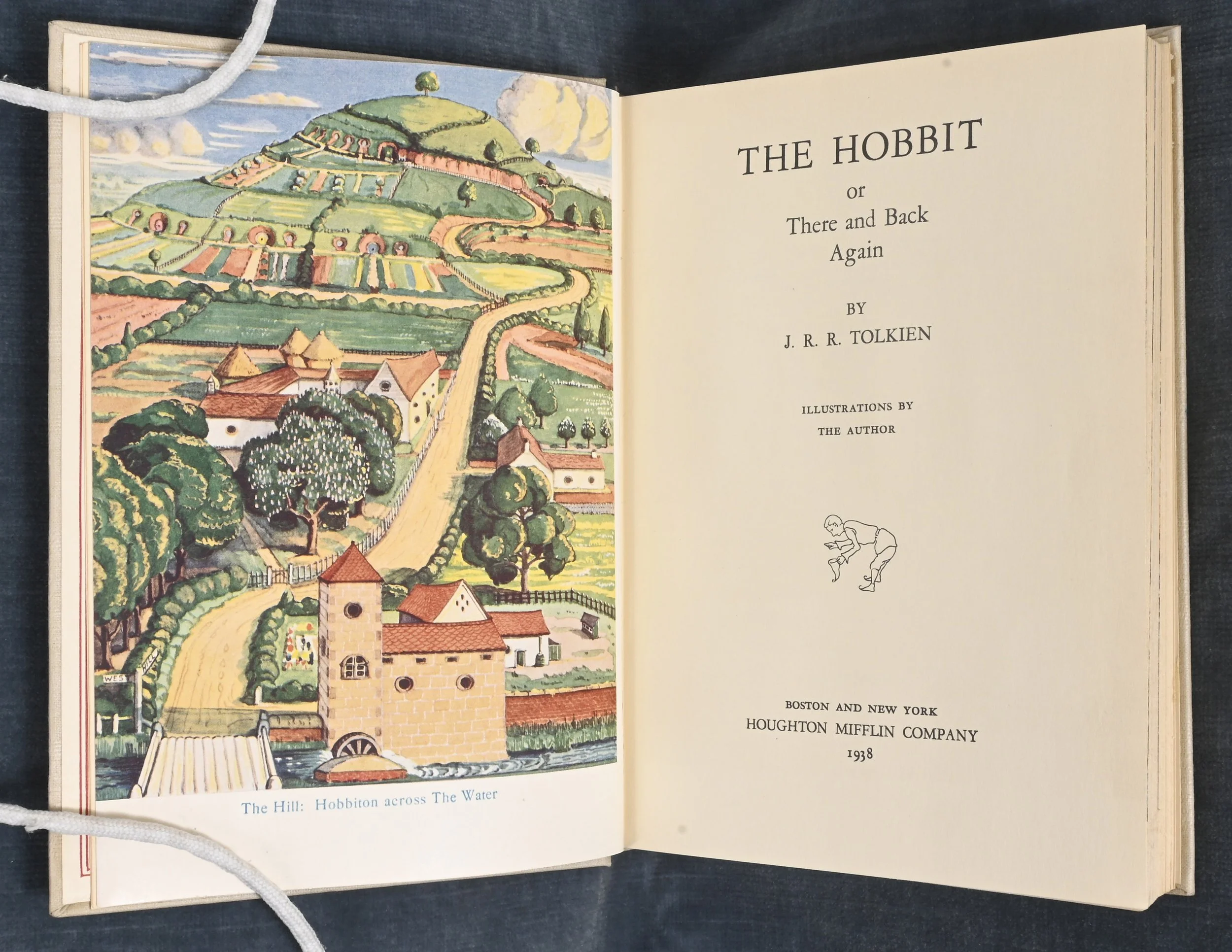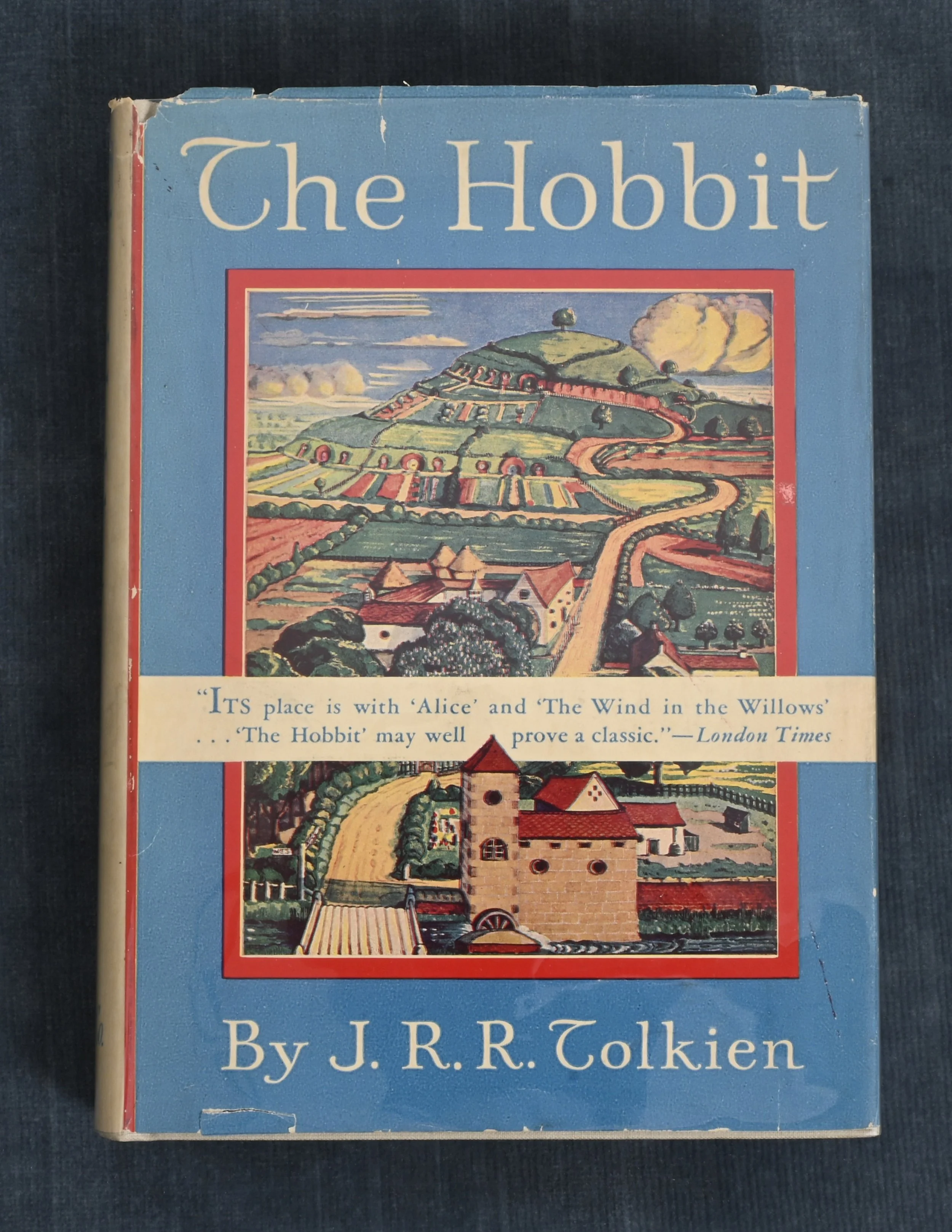Happy Birthday, Bilbo and Frodo! The Rosenbach Celebrates Hobbit Day with New Acquisition of The Hobbit
by Elizabeth Fuller, Librarian
J. R. R. Tolkien (1892-1973), author and illustrator. The hobbit, or, There and back again. — [First American edition]. — Boston and New York : Houghton Mifflin Company, 1938. (EL4 .T650h 938) This purchase was made possible with a grant from the Wyncote Foundation.
Every year on September 22, fans of Middle-earth celebrate Hobbit Day, the birthday of Bilbo and Frodo Baggins. This year, the Rosenbach is joining the festivities with our very own, recently acquired first American edition of J.R.R. Tolkien’s The Hobbit (1938). The purchase was made possible through the generosity of the Wyncote Foundation.
The acquisition of this adventure story follows a Rosenbach reading seminar course under way this fall, Reading J.R.R. Tolkien’s The Lord of the Rings with Professor Michael D. C. Drout. The Rosenbach already owns the first American editions of all three volumes of The Hobbit’s sequel, The Lord of the Rings (1956), as part of the library of Marianne Moore. They were a gift to Moore from her friend Bryher (1894-1983), a novelist, poet, and patron of other writers. We haven’t yet traced the source of Bryher’s interest in Tolkien, although she did correspond with both him and his son Christopher. However she learned of the book, she would have known about Moore’s interest in fairy tales and other forms of fantasy. Moore had recently published a translation of La Fontaine’s Fables and would later publish a retelling of Charles Perrault’s Puss in Boots, Sleeping Beauty, and Cinderella.
Difficult as it may be to imagine a time when high fantasy was not an omnipresent literary genre, when it first appeared there was very little akin to The Lord of the Rings, and critical reception was mixed. Some readers, like Tolkien’s friend C.S. Lewis and Moore’s friend W. H. Auden, compared it to Paradise Lost and Orlando Furioso. Others, approaching it from the Modernist perspective which emphasized departure from traditional forms and a search for truths that cannot be realized, could not take it seriously, as their often-superficial readings found it to be Romantic, escapist, antiquarian, and founded on certainties about good and evil.
The Hobbit had not had such difficulties when it was published nearly two decades earlier. It was written as a children’s book, built on stories that Tolkien told to his own children. Without the expectations placed on adult literature, it was well received by critics and won the Carnegie Medal, the highest British award in the field.
There were exceptions. Some, like Edmund Wilson (another friend of Moore’s), refused to take The Lord of the Rings or its admirers seriously from the beginning, seemingly based on The Hobbit’s intended audience. In his infamous review, “Oo, Those Awful Orcs!”, Wilson commented that “certain people – especially, perhaps, in Britain – have a lifelong appetite for juvenile trash.” Moore and Bryher both read this review, as Bryher wrote to Moore on May 2, 1956: “An immortal sentence in your last letter about Tolkien. ‘They are benedictory and bear a blessing which no one needs accept if he prefers himself to a flight of the mind.’ Wilson is a journalist used to checking and re-checking exterior facts. He has not understood Tolkien's purpose at all. I am glad you liked the volumes.” (Moore V:08:07) Luckily for us, many other readers have understood Tolkien’s purpose better than Wilson.
Reviews compared The Hobbit to Alice’s Adventures in Wonderland and The Wind in the Willows, two other books written for beloved children that have a significant place in the Rosenbach collections. Dr. Rosenbach’s purchase of the original manuscript of Alice in 1928 (now in the British Library) made world headlines, and early editions of Alice are now part of our extensive Lewis Carroll collection. Marianne Moore’s family read The Wind in the Willows in 1914 and folded it into their family folklore, using nicknames taken from it for the rest of their lives.
J. R. R. Tolkien (1892-1973), author and illustrator. The hobbit, or, There and back again. — [First American edition]. — Boston and New York : Houghton Mifflin Company, 1938. (EL4 .T650h 938) This purchase was made possible with a grant from the Wyncote Foundation.
In addition to Moore’s library, The Lord of the Rings and The Hobbit connect to other works in the Rosenbach collections. Tolkien, a philologist and scholar of medieval literature, wrote and taught about Chaucer throughout his career; we have two significant early manuscripts of the Canterbury Tales. Tolkien’s own experiment in high fantasy was also influenced by the works of several late-19th-century writers, including William Morris and George MacDonald, which are well-represented at the Rosenbach.
How will you celebrate Hobbit Day? Tolkien enthusiasts around the world will raise a mug of ale or tea, enjoy second breakfast, and (re)read the adventures of Bilbo and Frodo. We encourage you to enjoy some fellowship and read it with good company. As Bilbo said, “There's no knowing where you might be swept off to!” While Professor Drout’s Lord of the Rings course is sold out and under way, you can still register for recordings.


